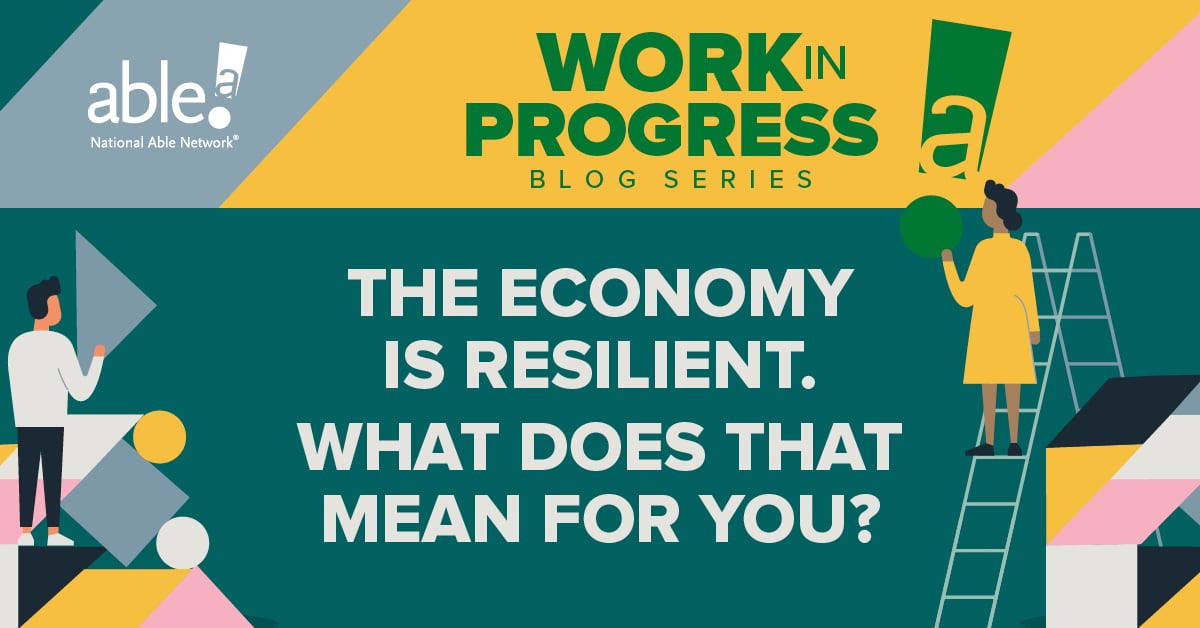In the first half of 2023, news headlines sounded like canaries in the economic coal mine: Key Indicator Puts the Chance of Recession at 100%, The US has a 100% chance of tipping into recession within 12 months, and so on. The threat of a recession was not only serious, but imminent, if the headlines and news articles were to be believed.
The economic recovery from the Covid-19 pandemic was coming in for a crash landing and workers (and employers) were bracing themselves for the worst. Then something interesting happened: the economy started growing, hiring remained strong, and wages started outpacing inflation. In a word, the economy showed its resiliency.
But what does economic resiliency mean, and how does it impact job seekers? For workforce development organizations like National Able Network demand for workers has remained strong but down from pandemic highs in 2021 and 2022. And although the Great Resignation has peaked, workers are still seeking out our resources to help them change jobs.
One definition of economic resiliency is provided by the U.S. Economic Development Administration (EDA), an arm of the federal government. The EDA describes economic resiliency as a local area’s “ability to prevent, withstand, and quickly recover from major disruptions (i.e., ‘shocks’) to its economic base.” These “shocks” can take the form of general economic downturns, like the Great Recession from 2007-2009, downturns in specific industries, like manufacturing, or disasters, such as the Covid-19 pandemic.
For example, during the pandemic, the unemployment rate spiked at 14.7% in April 2020 as most industries were shut down or severely restricted in an effort to curb the virus. But as of July 2023, the unemployment rate is 3.5% — close to a 50-year low.
The U.S. economy also continues to defy expectations and keeps growing, even when most economists have predicted a recession over the horizon. As reported in June 2023, the economy grew by 2.4% in the second quarter of the year, demonstrating that dire economic predictions have not come to pass. These are both excellent examples of the American economy’s resilience in the face of a black swan event.
But resiliency under these conditions can also be challenging for job seekers. One reason the unemployment rate decreased so quickly was due to extraordinary demand for workers to make up for the shutdowns; in 2022, the economy was adding 400,000 jobs per month. Now, though, the number of jobs added per month is down to 187,000. The demand for labor is softening, and with it, the wage growth and benefits packages that were offered by employers in a fierce labor market.
Job seekers should remain agile, whether they are looking to change jobs or re-enter the workforce after time away. Industries that were hot in recent years, like hospitality, have cooled off, while other industries, such as health care, are still looking to fill their ranks. Being able to apply to a variety of jobs is crucial if hiring slows.
One of the best ways to do this is to proactively brush up on desirable workforce skills. Local workforce resources are available that offer training, including on the job training, job preparation, and job placement. Supportive services like childcare are also often available. In Chicago, National Able Network offers a suite of services to job seekers, and in other regions, workers can visit their local American Job Center to learn about training and employment opportunities.

